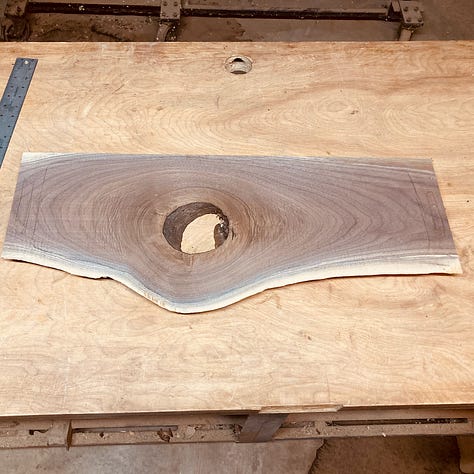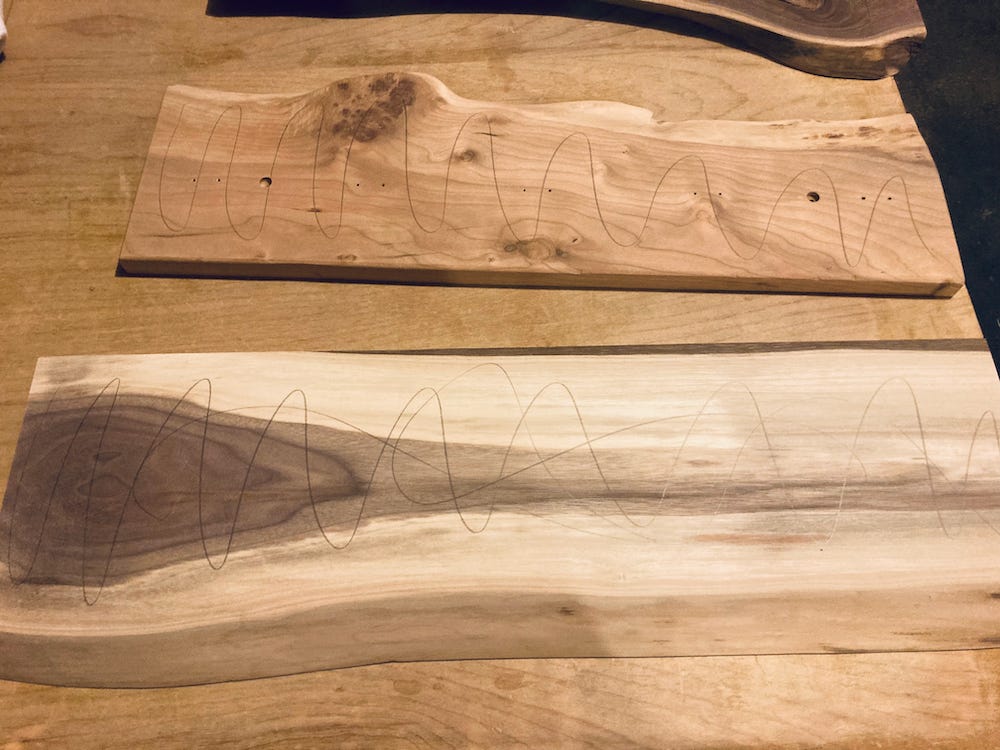A brief update: I’m in a business workshop, just started last night. It’s one thing to learn woodworking. Learning how to run a business is a whole different beast. My mind is awhirl with all there is to do. On a good note, there’s so much I haven’t been doing that once I start doing it (like marketing, for example), my little business will be peachy in no time.
Below are a few photos of the boards I’m working with. The one on the left is angled (thinner on one end and about 3–4” thick on the other end). It’s not terribly easy to work with, but I love it so much. The back is full of chainsaw marks, there’s some white rotted wood on one side, the bark has been a pain to remove. In my few free moments in the shop, I’m cleaning it up as best I can.



My essay is below. If you enjoy it, please consider clicking the ❤️ button.
Thank you for reading—I hope your days are full of useful scraps.
If you woodwork for long enough (more than a day or so), you end up with scraps. Small blocks, weird angle jobs, long thin strips. I have a bin stuffed with them. My dad has the equivalent of a storage shed full of scraps (we’re talking at least 225 sq. feet, and probably I’m underestimating).
Many find their way into permanent piles. I have two shelves under one of my shop tables stacked with scraps.
There’s a scene in the movie The Bourne Identity in which our protagonist needs a ride and tries to convince a woman, Marie, to drive him to France. He offers her money. But instead of just saying, “I’ll give you $10,000,” he throws her a brick of cash. The tangible is so much harder to say no to.
Sometimes I’m Marie, except instead of a stack of bills, I’ve got a scrap in my hand and my choice is to save it or toss it into the burn pile. Intense drama, I know.
If you’re a woodworker, you understand how hard it can be to pass up on something that could potentially be exactly the piece of wood you’re looking for at some unknown future point.
If you’re not a woodworker, pause and take this moment to fill your soul with empathy for the woodworker in your life.
The other scraps I collect are sentences and phrases and paragraphs, filling the notebooks in my life. I have a small leather-bound book for use in the shop. Another next to my bed. My phone’s notes app is filled with conversations I’ve jotted down.
Most of what’s in them is crap. Not the conversations—those are zingy one-liners from Josiah or our kids and each and every one is witty. But the scraps of thoughts in my notebooks are too often long-winded sentences that use 30 words to describe a situation or feeling when 10 would do fine.
However, some of what’s there becomes an essay that helps me figure out elusive ideas. Essentially, that’s what this newsletter is for.
The writing habit comes from my mom. Writing was not a pastime or a luxury in my childhood. It was a practice core to living, as necessary as turning groceries into dinner or paying bills.
Writing, my mom taught me, can reveal mental clutter; so revealed, it can be pared into something manageable.
Writing well, she would say, is a sign of thinking well.
If my sentences are cluttered and confused, chances are my thoughts on the topic are as well. Editing those 30 words down to 10 invites greater understanding.
Much like how I am in the shop, I also enjoy playing around with words, chiseling away at sentences to draw closer to the meaning I want to convey.
With woodworking, I can read about it or I can do it. My preference is the latter, even though it means making a lot of mistakes.
To me, writing is a similar act—I can either just think or I can do something with those thoughts. Simply thinking has the effect of making tough things worse (rumination) and deep thoughts shallow (for me, there’s no work in the thinking, the effort is in the writing).
When I’m writing something for you, I work to make it more enjoyable—writing that blends functional (connection between you and me) and beautiful (eh, maybe that’s a stretch, so how about words that clip along at a pain-free pace?).
That’s what I do with woodworking as well: try to make pieces that are functional and beautiful. Pieces that, as Dad tells it, please the eye and invite the hand.
Scraps are on my mind because I’m taking a break from big commissions this month (maybe next, too?) to make small pieces. So far I’ve made three charcuterie boards, three trays, a coat hanger, three shelves, a couple bowls, and one pen holder.
Some of these are from slabs pulled from the sawmill scrap pile; some are from small blocks I couldn’t bring myself to throw away months ago.
Many more scraps will continue gathering dust under my table or in my bin. Some will get burned in the wood stove. A few will provoke an “a ha!” moment in the months and years to come. An instant in which I will look at the block and see something else entirely, something that with time and effort can become more than just a piece of wood.
Writing I enjoyed
One of my favorite newsletters is the Growth Equation by Steve Magness and Brad Stulberg. Though I’m not one for setting resolutions, I enjoyed their first newsletter in 2023 about goals and resolutions. Stulberg writes:
When you think about resolutions or goals, I’d encourage you to think less about the outcome (e.g., lose weight, get promoted, run a marathon, start a blog) and more about the process (e.g., learn to listen to my body, try to excel at work, train for six months, write regularly).
These days, I’m all about process, because that comprises the majority of life. I wrote about it a few weeks ago. And a few weeks before that.
So maybe I only liked their essay because it resonates with what I already believe.
Tools and woodworking stuff
One of the attributes I love about the fine woodworkers I have gotten to know is how generous they are about sharing their insights and what they’ve learned. In that spirit, though I’m still a novice, I wanted to create a section about some of the woodworking equipment I use.1
One item that has improved my work: Abranet sanding discs.
These sanding discs are great because they don’t leave those little curlicues on the wood and they seem to generate less dust. Honestly, the curlicue issue was my main concern. I spend so much time sanding and to get to the end of that and find weird pig-tail squiggles remaining on the wood’s surface was maddening. My mentor recommended these to me (it’s the brand she uses) and helped me improve my sanding game.
My sanding process is as follows: I first use 80-grit, generally right after I’ve finished working on a piece and it has router marks (lately I’ve been using a router a lot) or planer lines on it. If there aren’t a lot of marks, I draw pencil lines all over the piece and sand until they are gone. Then I draw another set of pencil lines and sand with 120-grit or 150-grit, depending on my mood. Again with the pencil lines and sanding with 220-grit.

Depending on the piece, I leave it at that. With some of the Black Walnut boards, I’ve been going a step farther and sanding up to 400-grit and then using steel wool after the first coat of finish. Another friend had recommended this to me as it makes the color in the Walnut really pop.
If you’re a woodworker, what do you use for sanding? Any sanding tips you want to share?
Not an affiliate link or money-making thing on my part, just sharing info that’s been shared with me.








"Pieces that, as Dad tells it, please the eye and invite the hand."
Yes! You know you've made something nice when people instinctively reach out to feel it.
I think you're onto a good combination here; woodworking & writing, and I really enjoyed this essay.
I'll be back for more :-)
But I wouldn't be an aspiring ornery, old git if I didn't find something to complain about; May I venture an old pet grumble of mine? The expression "makes the grain / colour / etc. POP..." should be unceremoniously stuffed in and old paper bag together with a wad of linseed oil drenched rags and set alight.
Now I'm off for a sunday stroll with a little camera in my pocket. I think of it as 'walking with enhanced seeing' :-) Bye!
I’m currently trying to burn through my stash of miscellaneous 60 through 220 grit paper so I can justify placing an order for some 3M cubitron paper. I’ve heard great things.